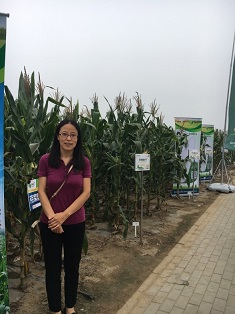 College of Grassland Science and Technology
College of Grassland Science and Technology
 Dr. Liping Ban
Dr. Liping Ban
Professor,
College of Grassland Science & Technology,
China Agricultural University (CAU).
Tel:13263162097
Email: liping_ban@163.com or lipingban@cau.edu.cn
Education
1999.9- 2004.6 Ph.D. Entomology, China Agricultural University, Beijing, China.
1994.9 - 1998.6 B.S. College of Horticulture, Inner Mongolia Agricultural University, China.
Professional experience
2020.1-Present Professor, Faculty Member, China Agricultural University, Beijing, China
2007.1-2019.12 Associate Professor, Faculty Member, China Agricultural University, Beijing, China
2004.7-2006.12 Assistant Professor, China Agricultural University, Beijing, China
2016.11-2017.4 Researcher at Washington State University, in the lab of Prof. Laura Lavine, Department of Entomology
2006.5-2007.5 Researcher at the Biological Chemistry Division, Rothamsted, UK, supported by Rothamsted International Fellowship
2005.8-2006.4 Post-doc Fellowship at the Sweden Agricultural University, Sweden, Dr. Robert Glinwood’s lab. Research on the ecological impact of an aphid virus (RhPV) on the bird cherry-oat aphid Rhopalosiphum padi.
2001.9-2002.3 Scholarship at the University of Pisa, Italy, in the lab of Prof. Paolo Pelosi in Pisa University, Italy. Research work on odorant-binding proteins (OBPs) and Chemosensory Proteins (CSPs) of Locusta migratoria.
Research
Broadly skilled grassland entomologist whose research has focused on pest management, and biocontrol of pasture pests. Her research has covered fundamental laboratory studies to understand insect behaviour and biology, field-based population studies through to the integration of pest management strategies and biological control of pests, including grasshopper,aphid, thrips et al on grassland and in forage production systems. Dr Ban has conducted sole research but also developed strong collaborations with researchers both in China and oversea.
Research projects (2015-2020)
2020-2023 Natural Science Foundation of China
Direct costs: 590, 000RMB
Title: Molecular mechanism of interaction between alfalfa virus and its vector insects
Role: PI
2017-2020 Innovation Research Projects in Beijing
Direct costs: 1.6 Million RMB (400, 000RMB/year)
Title: Integrated management of pests on the maize
Role: PI
2014-2017 Natural Science Foundation of China
Direct costs: 790, 000RMB
Title: The molecular mechanism of olfactory for receiving alarm pheromone in aphid
Role: PI
Teaching Experience
2018-present Teaching the course “Pest Control for grassland”
2018-present Laboratory Instructor for the course “Experiments of Grassland Protection”
2007-2014 Teaching Insect Section of the course “Plant Protection”
2007-2014 Laboratory Instructor for the course “General Entomology”
Publications (2015-2020)
1.Song LM, Gao YH, Li JD, Ban LP (2018) iTRAQ-based comparative proteomic analysis reveals molecular basis underlying wing dimorphism of pea aphids, Acyrthosiphon pisum. Front Physiol. .9:1016. DOI: 10.3389/fphys.2018.01016 (corresponding author)
2.Wang XM, Gao YH, Chen ZH , Huang JP, Cao JB, Li JD, Cui MM, Ban LP (2018) (E)-β-farnesene synthase gene affects aphid behavior in transgenic Medicago sativa Pest Management Science. DOI: 10.1002/ps.5153 (corresponding author)
3.Zhu J, Guo M, Ban L, Song LM, Liu Y, Pelosi P, Wang G (2018) Niemann-Pick C2 Proteins: A new function for an old family. Front Physiol. 9:52. doi: 10.3389/fphys.2018.00052. (co-first author)
4.Song LM, Wang XM, Huang JP, Zhu F, Jiang X, Zhang SG, Ban LP (2017) Ultrastructure and morphology of antennal sensilla of the adult diving beetle Cybister japonicas Sharp. PLoS One. 30;12(3): e0174643. doi: 10.1371/journal.pone.0174643. (corresponding author)
5.Wang XM, Li J, Ban LP, Yudi Wu, Wu XM, Wang YQ, Wen HY, Chapurin V, Dzyubenko N, Li ZY, Wang Z, Gao HW. (2017) Functional characterization of a gibberellin receptor and its application in alfalfa biomass improvement. Scientific Reports. 7, 41296; doi: 10.1038/srep41296
6.Jishan Jiang, Zhihong Chen, Ban LP, et al Wang XM. (2017) P-hydroxyphenylpyruvate dioxygenase from Medicago sativa is involved in vitamin E biosynthesis and abscisic acid-mediated seed germination. Scientific Reports. 7:40625
7.Zhu J, Ban LP, Song LM, Liu L, Pelosi P and Wang GR.(2016) General Odorant-Binding Proteins and sex pheromone guide larvae of Plutella xylostella to better food, Insect Biochemistry and Molecular Biology. 72:10-9. doi: 10.1016/j.ibmb.2016.03.005. (co-first author)
8.Iovinella I, Ban LP, Song L, Pelosi P, Dani FR. (2016) Proteomic analysis of castor bean tick Ixodes ricinus: a focus on chemosensory organs, Insect Biochemistry and Molecular Biology. 29:78:58-68. (co-first author)
9.Song LM, Jiang X, Wang XM, Li JD, Tu XB, Zhang ZH, Zhu F, Ban LP (2016) Male tarsi specific odorant-binding proteins in the diving beetle Cybister japonicus sharp. Scientific Report. 6, 31848; doi: 10.1038/srep31848. (corresponding author)
10.Ban LP, Sun YP, Wang Y, Tu XB, Zhang SG, Zhang YT, Wu YS, Zhang ZH.(2015)Ultrastructure of antennal sensilla of the peach aphid Myzus persicae Sulzer, 1776, Journal of Morphology. 276:219-227. (corresponding author)
11.Li J, Ban LP, Wen HY, et al (2015) An aquaporin protein is associated with drought stress tolerance. Bioch Biophys Res Commu 459, 208-213.
12.WangXM, Fu YY, Ban LP, Wang Z, Feng GY, Li J, Gao HW. (2015) Selection of reliable reference genes for quantitative real-time RT-PCR in alfalfa. Genes & Genetic Systems.